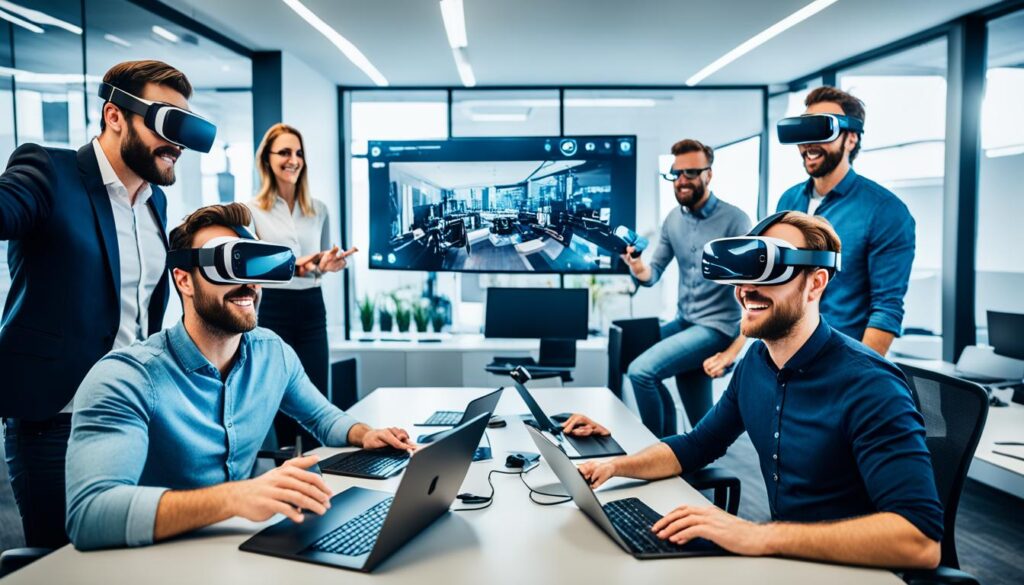Take your projects to the next level with a team of top-notch AR/VR developers. Get a dedicated AR/VR development team to make your immersive experiences stand out. Our experts can turn your ideas into amazing reality.
Table of Contents
Key Takeaways
- Hire a team of expert AR/VR developers to bring your vision to life
- Dedicated AR/VR development team to deliver cutting-edge immersive solutions
- Skilled professionals with expertise in transforming ideas into reality
- Captivate your audience with innovative AR/VR experiences
- Leverage the power of immersive technology to elevate your projects
Understanding the Realm of Augmented and Virtual Reality
Technology is changing fast, and augmented reality (AR) and virtual reality (VR) are leading the charge. These technologies are changing how we use digital content. They open up new possibilities in many areas.
Defining AR and VR Technologies
Augmented reality (AR) mixes the digital and real worlds. It lets users see virtual things added to their everyday life. Virtual reality (VR), on the other hand, takes users into a fully digital world. It feels like they are in a new place.
Applications and Use Cases
Augmented reality technology and virtual reality applications have many uses. They help in gaming, education, healthcare, and shopping. AR/VR use cases are changing how we live, work, and see the world.
In gaming, VR headsets make players feel like they are part of the game. In healthcare, AR and VR help with training and patient care. For shopping, AR lets customers try on clothes virtually before buying.
As immersive technology trends grow, AR and VR will change many industries. They will make things more efficient and fun. The future looks exciting with endless possibilities.
| AR Applications | VR Applications |
|---|---|
|
|
“AR and VR have the power to transform how we interact with the digital world, blurring the lines between the physical and virtual realms.”
The Need for Skilled AR/VR Developers
Creating immersive AR and VR experiences needs special skills in complex programming. It’s key to hire AR/VR developers who know their stuff. They must have the right technical skills.
Expertise in Complex Programming Languages
AR and VR experiences need a deep programming knowledge. AR/VR developers should know languages like C++, C#, and Unity. They should also be good with tools like ARKit, ARCore, and WebXR. This knowledge is vital for making your ideas come to life and giving users a smooth experience.
- Proficiency in C++, C#, and Unity for building strong AR/VR apps
- Expertise in ARKit, ARCore, and WebXR frameworks for immersive experiences
- Ability to handle the tough parts of complex AR/VR development and offer top-notch solutions
With a team of skilled AR/VR developers, you can make the most of these new technologies. You’ll create experiences that grab your audience’s attention and keep them coming back for more.
“The future of technology lies in the seamless integration of the physical and digital worlds, and AR/VR developers are at the forefront of this revolution.”
Benefits of Hiring Dedicated AR/VR Developers
Working with a team of dedicated augmented reality (AR) and virtual reality (VR) developers brings many benefits to your project. They bring specialized skills that can make your immersive experiences better. This leads to great value for your customers.
One big plus is their access to new technologies and insights. These experts keep up with the latest in AR/VR. This means they can add cool features and trends to your project. Their knowledge helps your project stand out.
Also, these developers work efficiently. They use their experience to make the development process smooth and quick. This means your project can be delivered on time and at a lower cost. It also means you can get your product to market faster.
Another big benefit is their skill in making immersive experiences that are just right for your audience. They know how to design AR/VR apps that meet your audience’s needs. This makes your product more engaging and helps you compete in the AR/VR market.
| Benefit | Description |
|---|---|
| Access to Cutting-Edge Expertise | Dedicated AR/VR developers stay up-to-date with the latest advancements, enabling you to incorporate innovative features and functionalities. |
| Efficient Development Processes | Leveraging their extensive experience, dedicated developers can streamline the entire development lifecycle, delivering cost-effective and timely solutions. |
| Customized Immersive Experiences | Dedicated AR/VR developers have the skills to design and develop bespoke applications that cater to your target audience, helping you stand out in the market. |
Working with a dedicated AR/VR team brings many benefits. You get benefits of hiring dedicated AR/VR developers, advantages of expert AR/VR team, and value of specialized AR/VR development. This can make your immersive experiences better and help your business succeed.
“Hiring dedicated AR/VR developers has been a game-changer for our business. Their expertise and innovation have allowed us to create truly captivating experiences that resonate with our customers.”
Key Skills to Look for in AR/VR Developers
The need for immersive experiences is growing fast in many fields. That’s why finding skilled AR/VR developers is key. They need a wide range of technical skills to make augmented and virtual reality apps that are smooth and fun.
Programming Languages and Frameworks
Knowing programming languages and frameworks is crucial for AR/VR developers. They should know languages like C#, C++, Java, or Python. They also need to be familiar with frameworks such as Unity 3D, Unreal Engine, ARKit, and ARCore. These tools help make experiences that work well on different devices.
UX/UI Design for Immersive Experiences
AR/VR developers also need to know a lot about UX/UI design. Making interfaces for virtual and augmented reality that are easy to use and look good is key. They should understand design principles, 3D modeling, and how to make interactions feel natural in these worlds.
| Key Skills for AR/VR Developers | Importance |
|---|---|
| Programming Languages and Frameworks | High |
| UX/UI Design for Immersive Experiences | High |
| Computer Vision and Spatial Awareness | High |
| 3D Modeling and Animation | High |
| Prototyping and Iterative Development | High |
By focusing on these skills when hiring AR/VR developers, companies can make sure they get people who can create amazing and engaging experiences. These experiences will really grab the attention of their audience.
The Process of Hiring Dedicated AR/VR Developers
Starting to hire AR/VR developers needs a careful plan. First, you must define your project requirements with your team. This helps you find the right people to make your AR or VR idea real and give users a smooth experience.
Defining Project Requirements
Before you start hiring, know what your project needs. This means understanding its goals, technical details, and what it aims to achieve. Knowing this lets you spot the right skills and knowledge in AR/VR developers. Think about these important points when setting your project needs:
- The type of AR/VR application or experience you aim to create (e.g., gaming, enterprise, education, e-commerce)
- The platforms and devices you plan to use (e.g., mobile, desktop, head-mounted displays)
- The level of interaction and user engagement you want
- How it will work with other systems or databases
- What performance, security, and growth you need
- Your project timeline and budget
Being clear about these needs helps you write a detailed job ad. This way, you draw in the best AR/VR developers who can make your idea happen.
“Defining the project requirements is the foundation for a successful AR/VR development initiative. It ensures you hire the right talent and sets the stage for a smooth and efficient development process.”
The process of hiring AR/VR developers and defining project requirements for AR/VR development work together. By taking time to detail your needs, you make hiring easier and boost your chances of finding the ideal team for your project.
Hire Dedicated AR/VR Developers
Developing immersive AR and VR experiences needs the right team. Finding skilled AR/VR developers is hard, but working with a trusted agency or platform helps. It makes finding the right person for your project easier.
With dedicated AR/VR developers, you get experts in the newest tech and best practices. They know complex programming languages like Unity, Unreal Engine, and WebGL. They also know how to make AR/VR apps that look great and work well.
To hire dedicated AR/VR developers, follow these steps:
- Define your project needs: Clearly state what you want from your AR/VR project. Include the features, user experience, and how it should work with other things.
- Research AR/VR development agencies or platforms: Find companies known for their quality AR/VR work and a wide range of successful projects.
- Check the agency’s or platform’s skills: See if the team knows the tech, has industry knowledge, and can meet your specific needs.
- Look at client feedback and case studies: Learn how happy clients are and the success of their AR/VR projects.
- Talk about project timelines and budgets: Make sure the agency or platform can finish on time and within your budget while delivering great results.
By doing these steps, you can find AR/VR developers who will make your vision come to life. They’ll help you lead in this fast-changing tech world.
“Hiring the right AR/VR development team can be a game-changer for your business. They bring the expertise and creativity needed to create truly immersive experiences that captivate your audience.”
Evaluating AR/VR Development Companies
Choosing the right AR/VR development partner is key. You should look at their portfolio, client feedback, and reviews. This helps you find the best company for your needs. You’ll get top-notch, innovative solutions that help your business grow.
Analyzing AR/VR Developer Portfolios
Looking at a company’s portfolio shows their skills, how they manage projects, and their work quality. Find a variety of projects that show they can handle tough challenges. They should also be able to make AR/VR experiences that are engaging and focus on the user.
Client Testimonials and Reviews for AR/VR Development
Talking to past and current clients gives you a clear view of the company’s good and bad points. Look for specific testimonials and online reviews. These should talk about how the company was to work with, their project management, and how the product helped the client’s business.
| Criteria | Importance | Evaluation |
|---|---|---|
| AR/VR Portfolio Depth | High | 4/5 |
| Client Testimonials | High | 4/5 |
| Online Reviews | Medium | 3/5 |
| Project Management Capabilities | High | 4/5 |
By looking closely at the AR/VR company’s work, client feedback, and reviews, you can make a smart choice. You’ll find a team that can bring you innovative and powerful AR/VR solutions for your business.
Considerations for Offshore AR/VR Development
Hiring offshore AR/VR developers can save money and give you access to more talent. But, you need to think about several things to make it work well.
One big thing to consider is time zone differences. Working with a team in another time zone can make talking and working together hard. You need to set up clear ways to communicate and make sure everyone is available at the same time.
Also, think about language and cultural barriers. Good communication is key in any project, and offshore teams might speak and work differently. Training on cross-cultural stuff and offering language help can help solve these problems.
When hiring remote AR/VR developers, keeping data safe is very important. Offshore teams might have different ways of protecting data. So, you need to have strong security steps and follow the rules.
Even with these challenges, the benefits of offshore AR/VR development are big. You get more talent, save money, and can work all the time. By paying attention to these points, companies can use offshore development to make great AR/VR projects.
“Offshore development can be a game-changer, but it requires careful planning and attention to detail to ensure a smooth and successful collaboration.”
Managing Remote AR/VR Development Teams
Managing remote AR/VR development teams is key to success. Teams need strong communication and collaboration tools for remote work. These tools help with teamwork and keep projects on track.
Communication and Collaboration Tools
Choosing the right communication and collaboration tools is vital. Tools that offer real-time updates, virtual meetings, and easy file sharing are great. Some top picks include:
- Video conferencing solutions like Zoom, Microsoft Teams, or Google Meet
- Instant messaging platforms like Slack or Microsoft Teams
- Cloud-based project management and collaboration tools like Trello, Asana, or Jira
- File-sharing and storage platforms like Google Drive, Dropbox, or Box
These tools help team members stay in touch, share updates, and work together, no matter where they are.
| Tool | Key Features | Benefits for Remote AR/VR Development |
|---|---|---|
| Zoom |
|
|
| Jira |
|
|
Using the right tools, remote AR/VR teams can work well together. They can keep projects moving and deliver top-notch immersive experiences.
“Effective communication and collaboration are the cornerstones of successful remote AR/VR development projects. Investing in the right tools can empower distributed teams to work together seamlessly and deliver exceptional results.”
Best Practices for Successful AR/VR Project Delivery
To make sure your AR and VR projects succeed, use agile methods and test continuously. These steps help you adjust to changes, find and fix problems early, and give users top-notch immersive experiences.
Agile Methodologies for AR/VR Development
Agile methods are key for AR/VR project delivery. They let teams work in cycles, respond fast to feedback, and keep improving the product. This way of working fits the changing needs of AR/VR projects well.
Continuous Testing and Quality Assurance
Testing and quality checks are vital for AR/VR apps. Make sure to test the app’s features, how it works on different devices, and the user experience often. This catches problems early and makes the final product better and more reliable.
| Best Practices | Description |
|---|---|
| Agile Methodologies | Use agile frameworks like Scrum or Kanban for iterative development, quick feedback, and ongoing improvement. |
| Continuous Testing | Have a detailed testing plan that checks functionality, compatibility, and user experience at every stage of development. |
| Quality Assurance | Create a QA team or process to make sure the app meets quality standards and offers a smooth user experience. |
Following these best practices for AR/VR project delivery, agile methodologies for AR/VR development, and continuous testing and QA for immersive experiences boosts your AR/VR project’s efficiency, quality, and success.
“Successful AR/VR project delivery needs a flexible, iterative approach that focuses on continuous testing and quality assurance.”
Emerging Trends in AR/VR Technology
The world of technology is always changing, and AR and VR are no different. These technologies are getting better fast. It’s important for businesses and developers to keep up with the latest trends.
AI and ML are big news in AR/VR. They make virtual and augmented experiences smarter and more personal. They can change content based on what users like and do.
5G technology is also changing AR/VR. It lets AR/VR apps work better and faster. This means we’ll see more AR/VR in things like gaming, entertainment, and healthcare.
New tech like better displays is making AR/VR devices more user-friendly. This means more people can enjoy AR/VR. The future of AR/VR looks bright with these new trends.
“The future of AR and VR is not just about the technology itself, but about how it can be leveraged to enhance our daily lives and transform the way we interact with the digital world.”
Businesses and developers are excited about the new possibilities in AR/VR. The future looks bright for new and exciting AR/VR applications. By keeping up with the latest tech, they can offer amazing experiences to their audiences.
AR/VR Development Cost Considerations
When planning your AR/VR development project, think about the costs that matter. The complexity of your app, the skills needed, and ongoing support are key factors. These can change your budget.
For a successful AR/VR project, knowing these costs is key. With a solid budget, you can use your resources well and meet your goals.
Factors Affecting AR/VR Project Budgets
- The type of AR/VR app you’re making affects its cost. Simple apps cost less, but complex ones with many features cost more.
- The features you add to your app also play a big role in the budget. Things like 3D modeling and multi-user interaction can raise costs.
- Working with existing systems or platforms can make your project harder and pricier.
- You’ll need to plan for ongoing costs like maintenance, updates, and support to keep your app running well.
Thinking about these factors helps you set a realistic budget for your AR/VR project. This way, you can make sure your project is successful and doesn’t go over budget.
| AR/VR Project Complexity | Estimated Development Cost |
|---|---|
| Simple AR/VR Experiences | $10,000 – $50,000 |
| Moderately Complex AR/VR Applications | $50,000 – $150,000 |
| Advanced, Feature-Rich AR/VR Solutions | $150,000 – $300,000+ |
Keep in mind, these are just rough estimates. The actual cost of your AR/VR project can change based on your needs and your team’s skills.
“Understanding AR/VR development costs is key to planning your project well.”
Integrating AR/VR Solutions with Existing Systems
It’s key to make your augmented reality (AR) and virtual reality (VR) work well with what you already have. Work with your team to make sure everything connects smoothly. This way, you get the most out of your immersive technology investments.
When adding AR/VR solutions to your setup, focus on a seamless connection with your current systems. This might mean linking it with your ERP or CRM software. By doing this, you make everything work together better, improving how you work and make decisions.
Also, make sure the AR/VR technology makes things better, not harder. Your team should talk with IT and operations to find and fix any issues. This way, you can make your current processes work better and more efficiently.
| Key Considerations for Integrating AR/VR Solutions | Benefits of Seamless Integration |
|---|---|
|
|
Putting a focus on seamless integration of AR/VR technology with your current systems can unlock big benefits. It can lead to a better user experience that helps your business grow and innovate.
Conclusion
Hiring AR/VR developers is a smart move that can take your projects to the next level. It brings in new, exciting ways to engage your audience. With a team of experts, you can fully explore what AR and VR can do. This puts you ahead in your industry.
Experts in AR/VR know a lot about complex coding and making experiences that are easy and fun for users. Adding these technologies to your business can make customers more involved, help with training, and open up new ways to grow and innovate.
Immersive technologies are becoming more popular, so the need for skilled AR/VR developers will keep going up. By investing in a team now, you can lead the way in your field. This can bring big benefits as this technology keeps getting better.














